
No.OO
BE5150SOBOA
From the library of: Superior Sewing Machine & Supply LLC

I.
GENERAL DESCRIPTION
l.
Remarkable features
CONTENTS
2.
Specifications
.........................................................................................................
2
II. INSTALLATION AND
OPERATION
l.
Installation............................................................................................................... 3
2.
Motor pulley and belt
.......................................................................................
3
3.
Preparation for operation
.................................................................................
4
III.
HOW
TO OPERATE THE MACHINE
I. Lubrication.............................................................................................................. 5
2.
Lubrication
of
the sewing hook
.....................................................................
6
3.
Attaching the needles
.......................................................................................
6
4.
Twist
of
thread
......................................................................................................
6
5.
Passing the needle thread
.................................................................................
7
6.
Passing the bobbin thread
.................................................................................
8
7.
Adjusting the thread tension
...........................................................................
8
8. Adjusting the stitch length
..............................................................................
10
9.
Reverse feed (LH-515)
........................................................................................
I 0
IV.
HOW
TO ADJUST THE MACHINE
l.
Timing
of
the bobbin case opening motion
.............................................
11
2.
Adjusting
the
bobbin case opening mechanism
.......................................
11
3.
Movement
of
the needle and the sewing hook
..........................................
12
4.
Adjusting
the
clearance between the needle and
the blade
point
of
sewing hook
...............................................................
13
5.
Detaching and attaching the sewing hook
................................................
14
6.
Adjusting the height of feed dog
..................................................................
14
7.
Adjusting the needle bar frame
.....................................................................
15
8.
Adjusting the maximum stitch length (LH-515)
.......................................
16
9.
Replacing the timing belt
.................................................................................
16
10. Adjusting the position
of
the timing belt
...................................................
17
V.
HOW
TO OBTAIN IDEAL SEWING CONDITIONS
Standard sewing conditions
....................................................................................
18
Troubles and corrective measures
........................................................................
19
From the library of: Superior Sewing Machine & Supply LLC

I.
GENERAL DESCRIPTION
JUKI Model LH-512
is
a high speed, 2-needle, needle feed, lockstitch industrial sewing
machine with a sewing speed
of
4,200
s.p.m.
JUKI Model LH-515
is
a high speed, 2-needle, needle feed, lockstitch industrial sewing
machine equipped with reverse feed mechanism, which
is
designed for withstanding
high speed operations
up
to
the
maximum sewing speed
of
3,500
s.p.m. and for aiming
at excellent durability.
1.
REMARKABLE FEATURES
o Link type thread take·up
This
type
of
industrial sewing machine has usually been designed
to
be operated
on
the
principle of a slide
type
thread take-up, although it was
not
sufficient in
sewing speed and durability. By overcomming such technical problems,
JUKI
Model LH-515 has successfully been designed
to
employ
the
link
type
thread
take-up mechanism which has sufficient durability
without
puckering
the
fabrics.
o Feed mechanism
This model employs a push
button
type
lead cam regulating system and also
needle bearings.
For
the
purpose
of
preventing any abrasion
or
seizure during a
high speed operation, a durable and seizure-free material is used
for
the
slide
block
type
feed driving mechanism.
o Lubrication system
The lubricating oil y.rhich
is
fed from
the
oil reservoir by means
of
the
plunger
pump
located on
the
hook
driving shaft
is
distributed
to
the
left and right
hook
driving shaft saddles, pushed
up
to
the
oil sight window
on
the
machine arm and
also
is
delivered
to
the
thread take-up lever shaft.
The
inside mechanism
of
the
face plate
is
constantly
lubricated through
the
oil wicks connected
to
the
thread
take-up lever shaft.
All
other
bearing metals are made
of
special sintered alloy which does
not
need
lubrication.
o Bobbin case opening mechanism
The
bobbin
case opening mechanism
of
the
Model LH-515
is
so designed as
to
achieve one
motion
while
the
sewing
hook
rotates twice, being different from
the
conventional models
of
which
the
mechanism achieves
two
motions. Thus,
the
improvement extends
the
life-time
of
the
sewing
hook
and minimizes
running noise.
o Hook shaft bearings
High speed feature and durability
of
this model
is
assured
by
employing
the
precision needle bearings in
the
upper
bushings
of
hook
shafts
on
the
both
left
and right.
-1-'-
From the library of: Superior Sewing Machine & Supply LLC

2.
SPECIFICATIONS
LH·515
Sewing
type
.......................... 2-needle, lockstitch, needle feed, with reverse feed
mechanism
(by
feed control lever).
Application ........................... Light and medium heavy weight materials. (Men's
shirts cuffs, front flies, attaching pockets
to
working
uniforms, felling trousers, attaching tapes
to
tricot
materials and sewing side face and waist inside
of
men's jackets, etc.)
Sewing speed ......................... Max.
3,500 s.p.m.
Thread take-up ...................... Link
type
thread take-up
Needle bar stroke ..................
33.4mm
( 1-5/ 16")
Needles .................................
DP
x 7, No.I I,
No.l4,
No.l6
or
DP
x 5, No.I I,
No.l4,
No.l6
Presser lifting amount ...........
7mm(9/32")
by hand lifter, 10mm(25/64")
by
knee
lifter.
Feed mechanism ...................
Bottom
feed and needle feed.
Stitch length ......................... Max.
4mm(5/32")
Stitch
length regulator .......... Feed eccentric adjustment system (by push
button).
Needle gauge .........................
3/32
11
, 1/8
11
,5/32
11
,
3/16",
7/32",
1/4",
9/32",
5/16",
3/8",
l/2",
5/8",
3/4",
7/8",
I",
1-l/8",
l-l/4",
1-3/8",
1-l/2''
Sewing hook ........................ Horizontally arranged automatic lubricating hooks for
high speed operation.
Lubrication system .............. Automatic lubricating system
by
means
of
plunger
pump and lead pump.
Driving
motor
...................... 3-phase 400W
0/2HP)
clutch mtor.
Table .................................. Table for model
LH-5
l 5
LH-512
Sewing type ........................ 2-needle, needle feed, lock stitch
Sewing speed .......................
Up
to
4,200
s.p.m.
(All
other
specifications are same
as
LH-515)
-2-
From the library of: Superior Sewing Machine & Supply LLC

II.
INSTALLATION AND OPERATION
1.
INSTALLATION
The
following procedure will simplify
your
installation works;
(1) Hinges
First
of
all,
you
must fix
the
machine head
onto
the
table
by
means
of
the
accessory
rubber
hinges.
Make suitable recessions on
the
table using a round
or
straight chisel so
that
the
width
and thickness
of
such
rubber
hinges tightly fit
them
and nail
the
hinges on
their
positions
with
2 pieces
of
nails.
(2) Setting
the
oil reservoir
The oil reservoir must
be
set
in
the
opening prepared on
the
table so
that
it
is
supported by 4 corners
thereon
as
shown in
the
illustration.
---
~
~~F~
~
Hmark
-~
Fig.
1
~I
2.
MOTOR PULLEY AND BELT
1.
Nail
4mm
thick felts
on
the
two
corners
of
the
near side
of
the
table
opening
(operator's
side).
2.
Similarly, nail
6mm
thick
felts on
the
two
corners
of
the
far side (hinge
side).
3.
Place
the
oil reservoir on
top
of
these
felts.
4.
Insert rubber cushions
into
4 corners.
5.
Put
the
round felts over
the
rubber
cushions.
(Note) Knee press rod bearing
bracket
CD
should be installed as
shown
in
the
figure.
Use a 3-phase
400
W motor. The belt
is
M-type V belt.
Following tab!e shows the relationship between
the
number
of
rotation
of
the
machine
with
the
dimension
of
the
motor
pulley (effective diameter).
Rotation
Part No.
of
motor
pulley
Effective dia.
of
machine
of
motor
pulley
4,200 s.p.m.
MTK-
PV 1
00000
· 100
rp
4,000 s.p.m.
MTK-P0095000
95
rp
50
Hz
3,800 s.p.m.
MTK-PV090000
90
rp
3,400 s.p.m.
MTK-PV080000
80
rp
3,000
s.p.m.
MTK-PV070000
70
rp
-3-
From the library of: Superior Sewing Machine & Supply LLC

Rotation
Part
No. of
motor
pulley
Effective dia.
of
machine
of
motor
pulley
4,200
s.p.m.
MTK-PV085000
85 ¢
4,
000
s.
p.m.
MTK-P0080000
80 ¢
60Hz
3,800
s.p.m.
MTK-PV075000
75
¢
3,400 s.p.m.
MTK-P0065000
65
¢
3,000
s.p.m.
MTK-
PV060000
60
¢
(Note)
For
the first one
month,
operate
the
LH-512 machine with a speed
of
less than
3,800
s.p.m.
For
LH-515, operate
the
machine with less than
3,000
s.p.m.
In the meantime, the machine will warm
up
appropriately.
3.
PREPARATION
FOR
OPERATION
(I)
Fill the oil reservoir with lubricating
oil
up
to
the level marked
with
"H",
take
an
urethane
foam sheet
out
of
the accessory box and place
it
under
the
hook
driving
shaft
saddles
to
absorb noise and dust.
(2)
Those machines which are
operated
for the first time
after
setting
up
or
after
a long period
of
disuse,
you
must apply 2
or
3
drops
of
oil
through
the oil holes
j)
as shown in
Fig.2.
Fig.
2
(3)
Provide
your
machine with
an
idle
run
after
pushing
up
the
presser
foot,
and
the
lubricating oil will be circulated slowly
to
the
oil gauge
within
2 ~ 3 seconds.
(4)
Precaution
o If
you
have
to
wait for 10 seconds
or
more until
you
observe
the
lubricating oil in
the oil gauge, verify the following points:
(a)
If
the volume
of
oil
is
too
short,
(b)
If
the
plunger
pump
is
normally running.
(If
the plunger has
not
been aligned with the groove on the
hook
driving shaft,
the
lubricating oil will
not
be delivered pl·operly. In such a case, correct the
position
of
the bushing on the
hook
driving shaft accordingly.)
o When the oil has reached the
"L"
mark
of
the
oil reservoir,
stop
running the
machine.
Be
sure
to
verify
that
the oil is completely filled
up
to
the
"H"
mark.
-4-
From the library of: Superior Sewing Machine & Supply LLC

Ill.
HOW TO OPERATE THE MACHINE
1.
LUBRICATION
The
amount
of
oil
to
lubricate
the
face
plate mechanism has normally been ad-
justed at
our
factory before shipment.
If
necessary, you may adjust it
by
turning
the
adjusting screw shown in
the
Fig.3.
The stable
amount
of
oil
is
constantly
supplied
to
. the face plate mechanism
from
the
thread take-up lever shaft
through
the
oil wicks.
Check the following points:
Fig.
3
(I)
2 oil wicks
(3c/>)
must be passed through
the
thread take-up lever shaft.
(2)
The
oil adjusting screw (Fig.3) located under the machine bed should have been
screwed in
by
3 or 4 turns.
(3)
The
tips
of
oil wicks sheathed with aluminium pipe are very slightly touching the
surfaces
of
the needle crank rod and
the
needle bar.
(4)
To
check the amount
of
oil:
Hold a piece of rough paper facing
to
the mechanism
as
shown
in
Fig.4 so
as
to
blot
it
with
splashed
oiL
Run the machine for 5 seconds and then stop it for 5
seconds, repeat this intermittent test for 2 minutes and judge the amount of oil
from the blot on
the
paper under
the
bright sunlight or artificial light. Fig.5 shows
the optimum distribution
of
oil spots on the test paper.
(5) The lubricating oil must come up in the oil gauge within 3 seconds after
the
machine has been started
to
run.
• •
Fig.
4
Fig.
5
-5-
From the library of: Superior Sewing Machine & Supply LLC

2.
LUBRICATION TO THE SEWING
HOOK
The
amount
of
oil
to
lubricate
the
sew-
ing
hook
is
increased
by
tightening the
adjusting screws
<D
in
Fig.6 and de-
creased by loosening them.
3.
ATTACHING THE NEEDLES
(I)
DP
x 5
or
DP
x 7 needles must be
used for this model.
(2) Insert 2 needles fully
into
the needle
clamp in such a manner
as
to make
their long grooves face with each
other
as
shown
in
Fig. 7 and securely tighten with
the
clamp screws.
--
rT
<f)
<D
"''I
...
I
,,.J
i•"
,~
...
,
:
.....
,
!'C
: I
'
)/
'
Needle size Thread size
Sewing material
No.I I
No.80
to
No.lOO
Calico
of
light
weight, broad
cloth
Y.
: H
I I :
I '
I 1
I
No.l4
No.60
to
No.80
Calico, Gabardine
of
light weight
No.16
No.40
to
No.60
Woolen fabric,
Gabardine
I
I
r
·~
No.l8
No.30
to
No.20
Vinyl-leather
Fig.
7
4.
TWIST OF THREADS (Fig.8)
We
recommend you
to
use a S-twist (left twist) thread ® for the left needle and a
Z-twist thread (right twist)
® for the right needle. If not, loosely twisted threads or
thicker threads
than
No.30 may be frequently broken
at
the left hand needle. Either
twist
of
threads
can
be used for
the
bobbin thread.
®
Fig.
8
- 6
--
From the library of: Superior Sewing Machine & Supply LLC

5.
PASSING THE NEEDLE THREADS
Pass the needle thread in the order shown in Fig.9.
The needle thread
to
be passed through
the
left hand needle (seeing from the
operators' side) must be passed in the order
of
<D
to
® (Left thread tension disc
-+
thread take-up lever upper hole
-+left
needle). The right
hand
needle
must
be passed
in the order
of
®
to
® (Right thread tension disc
-+
thread take-up lever lower
hole
-+
right needle).
Fig. 9
-7-
From the library of: Superior Sewing Machine & Supply LLC

6.
PASSING THE BOBBIN THREAD
When
you
pull
out
the
bobbin
thread
through the bobbin case holder, verify
that
the thread
is
passed through the
notched
part
<D
thereof
without
fail,
as
shown
in
Fig.l
0.
7.
ADJUSTING THE THREAD
TENSION
(1)
Needle thread tension.
For
obtaining optimum needle thread
tension, turn the thread tension post
nut
<D
of
Fig.ll
for the right hand
needle thread and
the
nut
® for the
Fig.
10
left
hand needle thread. The thread tension will be increased by clockwise turn and
decreased by counterclockwise turn.
(2) Bobbin thread tension.
For
adjusting the bobbin thread tension, turn the adjusting screws
<D
of
Fig.l2
on
the
left and right bobbin case holders. Clockwise
turn
increases and counter-
clockwise
turn
decreased the bobbin thread tension.
Fig.
11
Fig.11
- 8 --
From the library of: Superior Sewing Machine & Supply LLC

(3) Tension
of
thread take-up spring.
For
adjusting
the
tension
of
the thread take-up spring,
turn
the thread take-up
spring stud
(['
of
Fig.l3. The tension
is
increased
by
clockwise
turn
and decreased
by
counterclockwise turn. After adjustment, lock
it
by
tightening
the
thread
tension post
nut
®
of
Fig.l3.
Normally, the tension
of
the thread take-up spring
is
ahout
20
g.
and the stroke
is
7mm(9/32")
to
10mm(i3/32
11
).
When you sew a very
light fabric or a synthetic fiber material,
you
must lessen the spring tension and
increase it's stroke.
To
change the stroke
of
the thread take-up spring, loosen the screw
<D
of
Fig.l4
and slide the stopper ®
to
the right for increasing and
to
the left for decreasing.
Fig.
13
Fig.
14
-9-
From the library of: Superior Sewing Machine & Supply LLC

8.
ADJUSTING THE STITCH LENGTH (Fig.15)
As
you
keep on pressing
down
the
button
CD
on
the machine bed, rotate the hand
wheel
® manually. When
the
·button·is engaged with a groove, adjust a desirable
stitch length, which is indicated
by
the
graduations
on
the handwheel,
to
the
pointer®
Kl
!
Fig.15
Fig.
16
9.
REVERSE FEED (LH-515)
To
produce
the
reverse stitches, press down the feed lever
CD
Fig.l6
fully until
it
is
limited by the stopper. The reverse feed is
kept
as long
as
you press it.
-10-
From the library of: Superior Sewing Machine & Supply LLC

IV. HOW TO ADJUST THE MACHINE
1.
TIMING
OF
THE BOBBIN
CASE
OPENING MECHANISM
When the
upper
line engraved
on
the needle
bar
(CD
of
Fig.l7)
coincides with the
bottom
surface
of
the needle bar frame ( ® of
Fig.l7),
in other word, when the needle
bar has gone
up
by 0.2
~
0.3mm(l/l28"
~
3/256")
from
it's
bottom
dead point,
two
engraved marks located od the pivot
of
the bobbin case opening lever link must aligned
with each
other
as
shown in Fig.l8.
Fig. 17
Fig.18
2.
ADJUSTING THE BOBBIN
CASE
OPENING MECHANISM
Adjust the position
of
the bobbin case opening lever
(CD
of
Fig.20) so
as
to
open the
bobbin case holder allowing the thread
to
pass through depending
upon
the thickness
of
such thread
at
the moment when
the
needle thread
is
pulled
up
along
the
bottom
surface
of
throat
plate
as
shown in
Fig.l9.
To adjust the said lever, loosen
the
screw
( ® of Fig.20),
obtain
a correct position and finally tighten
the
screw. You must be
careful
not
to
allow it
to
open the bobbin case holder
too
much, or the sewing
hook
may make a high noise and shorten
it's
lifetime.
Fig.
19
Fig.
20
-
11-
From the library of: Superior Sewing Machine & Supply LLC

3.
MOVEMENT
OF
THE NEEDLE AND THE SEWING HOOK
(1
I
Timing
of the needle
and
the sewing hook (Fig.21A &
21
B)
Set
the
feed
amount
to
2mm(5/64"),
and remove
the
throat
plate.
o When the needle has gone
up
2mm(5/64
11
) from it's
bottom
dead point,
the
timing
of
the needle and
the
sewing
hook
is
as shown
in
Fig.
21
A.
0 When
the
points
of
left and right sewing hooks coincide
with
the
center
lines
of
their needles,
the
clearance between each
hook
point and
the
needle face
is
0.05mm
as shown in Fig.21B.
o The
hook
point must point
at
a higher level
by
1.2mm(3/64
11
)
than
the
top
edge
of
needle eye as shown in Fig.21A.
2mm
0.05mm
Fig.
21A
Fig.
218
(Note)
The upper engraved marking line on
the
needle
bar
will coincide with the
bottom
surface
of
the
needle
bar
frame, when
the
needle bar
is
at
the
bottom
dead point.
The lower engraved line
thereon
will coincide with the
bottom
surface
of
the
frame,
when the needle bar has gone up by
2mm(S/64
11
) from it's
bottom
dead point.
-12-
From the library of: Superior Sewing Machine & Supply LLC

(2) Matching
the
timing
of
the
sewing
hook
Loosen
the
set screw ( Q)
of
Fig.22) on
the
small gear which drives
the
hook
driving shaft (small) and adjust
the
tim-
ing
of
sewing hook.
In
order
to
eliminate any vertical loose-
ness,
after
adjustment,
you
must tighten
the
said screw
with
such a
manner
as
to
push down
the
hook
and
to
pull
up
the
gear at
the
same time.
4.
ADJUST THE CLEARANCE BETWEEN THE NEEDLE
AND
THE HOOK POINT
(Fig.23)
Adjust
the
clearance
by
correcting
the
sewing
hook
position according
to
following
way:
(a)
Remove
the
presser foot and the
throat
plate.
(b) Tilt
the
machine head backwards.
(c)
Loosen 3 screws which fix a
hook
driving shaft saddle (A, B screws
are
for
the
right
saddle; A', B' screws are for
the
left saddle.)
(d)
Tap
the
hook
driving shaft saddle gently
to
correct
it's
position.
(e)
Tighten
the
screws A(A') and B(B') and finally fix
the
saddle.
A
-13-
Fig. 23
From the library of: Superior Sewing Machine & Supply LLC

5.
DETACHING
AND
ATTACHING
THE SEWING HOOK
(1) Detaching the sewing hook.
(a)
Open the bed slide
..
(b) Bring up
the
presser foot and
remove
the
throat
plate.
(c) Loosen 2 hexagon socket head
screws
(CD
of
Fig.24), which fix
a sewing
hook
to
it's driving shaft,
by
using a hexagonal spanner
stored in the accessory box.
(d) Bring up the needle
at
it's
top
dead point
by
manually rotating
the
handwheel and take out
the
sewing hook upwards.
(2) Attaching the sewing hook
(a)
Reverse the procedures mentioned in
(1
).
Fig.
24
(b) Before attaching the
throat
plate, manually rotate the bobbin case holder so
that
the protruding part thereof agrees with the groove on the
throat
plate.
6.
ADJUSTING THE HEIGHT OF
THE FEED
DOG
The standard height
of
the
feed dog
measuring from the
top
surface
of
the
throat plate
is
0.8mm(l/32"),
as
shown
in
Fig.25. Adjust it,
if
necessary, by
loosening 2 screws which set the feed
dog.
-
14-
Fig.
25
From the library of: Superior Sewing Machine & Supply LLC

7.
ADJUSTING THE NEEDLE BAR
FRAME
The
correct clearance between
the
outer
surfaces
of
the needle bar and the pres-
ser
foot
is
14mm(35/64")
measuring
bottom
surface
of
the
presser bar bush-
ing when
the
stitch length has been set
to
Omm,
as
illustrated in Fig.26
Fig.
26
The correctly adjusted feed movement
is
proved by the motion
of
the
needle which
constantly follows
up
the
movement
of
the feed dog and
is
always pointing at
the
center
of
the needle hole on the feed dog.
For
adjusting
the
longitudinal position
of
the
needle
bar
frame, loosen
the
clamp screw
( ®
of
Fig.27) on
the
needle bar rock shaft driving rod crank
(CD
of
Fig.27), adjust the
needle bar so
that
the needles are pointed
at
the
center
of
the
needle hole
on
the
feed
dog and re-tighten the clamp screw.
If
the rock shaft driving
rod
( ®
of
Fig.27) hits
the
surface
of
the arm, loosen the
clamp screw
(CD
of
Fig.28)
on
the
rock shaft driving arm (rear) before tightening the
screw
(CD
of
Fig.27), pull the driving rod crank fully towards you, re-tighten
the
clamp
screw
(CD
of
Fig.28) at the point where
the
said clearance between
the
needle bar and
the
presser bar becomes
16.
5mm(21/32"),
and finally align
the
needles with
the
needle
holes on the feed dog as mentioned before.
Fig.
27
Fig.
28
-IS-
From the library of: Superior Sewing Machine & Supply LLC

8.
ADJUSTING THE MAXIMUM STITCH LENGTH(LH-515)
When
you can
not
get the maximum stitch length, you can adjust it
by
changing the
position of the feed limiting plate (
d)
of
Fig.29) located on the back side
of
the
machine bed.
If the maximum stitch length
of
the
normal feed
is
not enough, tilt the machine head
backwards, loosen 2 screws (
®
of
Fig.29) clamping the feed limiting plate and slip the
plate upwards.
If
the
stitch length is
too
long, on the contrary, slip the said plate
downwards and re-tighten the screws firmly. After adjustment you must measure the
maximum stitch length for the distance
of
II
stitches by manually forming such
stitches on a piece
of
paper.
The maximum stitch length
of
the reverse feed can be adjusted by changing the height
of
the feed limiting plate using the adjusting screw
(@
of
Fig.29). Loosen the lock nut
(@
of
Fig.29) and turn the screw clockwise for increasing the stitch length or counter-
clockwise for decreasing.
9.
REPLACING THE TIMING BELT
Firstly, you must remove
the
reverse
feed control lever shaft. Tilt
the
machine
head backwards and loosen 2 screws
which set the arm
to
the
control lever
shaft. And remove the end screw which
is
located on
the
opposite side
of
the
feed lever and take
out
the
lever and
it's
shaft as they are assembled together
from
the
machine head towards the
right hand side.
(l)
Disengage the timing belt from
the
sprocket wheels.
(2) Take
out
the
handwheel together
with the built-in bearing.
(3)
Pull
out
the timing belt from the
opening made by
® and insert new
belt for replacement with care not
to
give
any sharp
bentto
the
new belt.
-
16-
Fig.
29
From the library of: Superior Sewing Machine & Supply LLC

10.
ADJUSTING THE POSITION OF THE TIMING BELT
After
replacing
or
disengaging
the
timing belt from
the
sprockets,
you
must adjust
the
position
of
it so as
to
match
the
movements
of
the main shaft and
the
hook
driving
shaft with each other.
Rotate
the
main shaft in
the
normal direction
until
the
needle has
come
down
to
the
same level as
the
top
surface
of
the
throat
plate as shown
in
Fig.30, then,
rotate
the
hook
driving shaft
in
the
normal direction
until
the
first screw
on
the
lower
sprocket
wheel (
®
of
Fig.31)
is
aligned
with
the
timing mark ( ®
of
Fig.3l)
and
put
the
timing
belt
on
at this position.
Fig.
30
Fig.
31
-17-
From the library of: Superior Sewing Machine & Supply LLC

V.
HOW
TO OBTAIN THE IDEAL SEWING CONDITIONS
o STANDARD SEWING CONDITIONS
Thickness
Tetoron
Nylon
Cotton Cotton
Vinyl on
of
thread
No.
SO
No.60 No.
SO
No.
SO
No.30
Sewing
Tetoron
Tetoron
Cotton Cotton
Vinyl-
broadcloth
broadcloth gabardine gabardine
leather
material
2 sheets
2 sheets 2 sheets 2 sheets 2 sheets
Needle
DPx
7 DP X 7
DPx
7
DPx
7
DP
X 7
No.I I
No.l4
No.l4
No.l4
No.l8
Needle
thread
20g
25
to
30g. 45 to 50g. 50 to 60g. 80 to
lOOg.
tension
Bobbin
thread 15 to
20g,
15
to
20g. 25 to 30g.
25
to 30g. 30 to 40g.
tension
Thread
take-up
15g.
15g. 25g.
25g.
30g.
tension
Thread
12mm 12mm
lOmm lOmm 12mm
take-up
(15/32")
(15/32")
(25/64") (25/64") (15/32")
stroke
Sewing
speed.
3,500
3,500
3,500 3,500 3,500
(s.p.m.)
-18-
From the library of: Superior Sewing Machine & Supply LLC
Page is loading ...
Page is loading ...
Page is loading ...
Page is loading ...
-
 1
1
-
 2
2
-
 3
3
-
 4
4
-
 5
5
-
 6
6
-
 7
7
-
 8
8
-
 9
9
-
 10
10
-
 11
11
-
 12
12
-
 13
13
-
 14
14
-
 15
15
-
 16
16
-
 17
17
-
 18
18
-
 19
19
-
 20
20
-
 21
21
-
 22
22
-
 23
23
-
 24
24
Ask a question and I''ll find the answer in the document
Finding information in a document is now easier with AI
Related papers
-
Juki DDL-8700BH-7 User manual
-
Juki DDL-8700A-7 User manual
-
Juki DLD-432-4 Instruction book
-
Juki DDL 553 Instruction book
-
Juki DDL8700B-7 Owner's manual
-
Juki DDL-8000A User manual
-
Juki LK-1852-20 Engineer's Manual
-
Juki MB-372 Instruction book
-
Juki DDL-555-2 Instruction book
-
Juki LH-4128-7 User manual
Other documents
-
Rod Desyne SPT-O-36-1 User manual
-
Mitsubishi Electric LT2-2250-B1T User manual
-
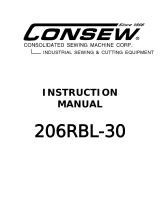 Consew 206RB-5 User manual
Consew 206RB-5 User manual
-
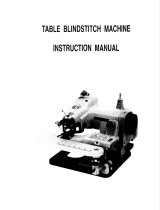 Consew 75T User manual
Consew 75T User manual
-
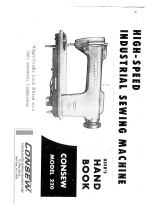 Consew 220 User manual
Consew 220 User manual
-
SunStar KM-341BL User manual
-
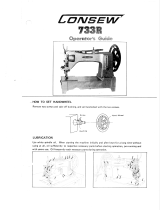 Consew 733R User manual
Consew 733R User manual
-
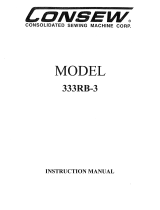 Consew 333RB-3 User manual
Consew 333RB-3 User manual
-
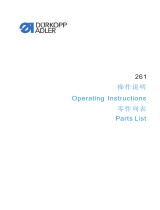 Duerkopp Adler 261_valid_till_november_2019 Operating instructions
Duerkopp Adler 261_valid_till_november_2019 Operating instructions
-
 Consew 226R Operating Instructions Manual
Consew 226R Operating Instructions Manual






























